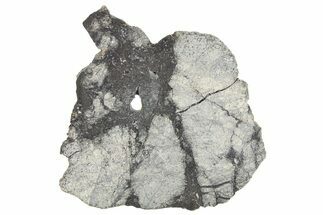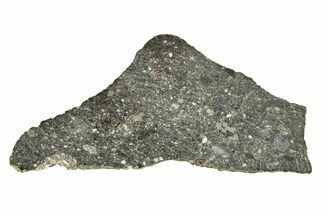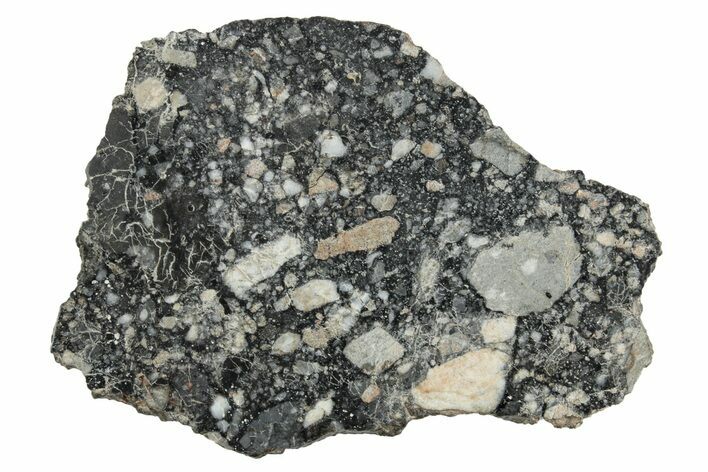This Specimen has been sold.
3.41" Lunar Meteorite Slice (24.14 g) - NWA 15583 Paired Stone
This is a 3.41" wide (24.14 gram) polished slice of a lunar meteorite which is almost certainly a paired stone with NWA 15583. It displays striking, large anorthite-rich lithic clasts ranging from white to peach in color against a dark grey background.
Technically speaking the particular stone this slice came from is still pending classification, but it is a near certainty to be a paired stone with NWA 15583. A paired stone means it was originally part of the same meteor which broke apart after entering Earth's atmosphere. The stone came from the same source, was collected in close proximity to NWA 15583, and bears all of the same characteristics. The individual stone will receive a new NWA number once the classification is complete.
Technically speaking the particular stone this slice came from is still pending classification, but it is a near certainty to be a paired stone with NWA 15583. A paired stone means it was originally part of the same meteor which broke apart after entering Earth's atmosphere. The stone came from the same source, was collected in close proximity to NWA 15583, and bears all of the same characteristics. The individual stone will receive a new NWA number once the classification is complete.
About Meteorite NWA 15583
NWA 15583 is represented by a single 3.4-kilogram stone discovered in 2022. It was classified in early 2023 as a lunar feldspathic breccia meteorite.
Meteoritical Bulletin: Entry for Lunar Meteorite NWA 15583
NWA 15583 is represented by a single 3.4-kilogram stone discovered in 2022. It was classified in early 2023 as a lunar feldspathic breccia meteorite.
Meteoritical Bulletin: Entry for Lunar Meteorite NWA 15583
Moon Rocks... On Earth...
Think the only moon rocks on Earth are samples brought back from Apollo missions? Think again!
Lunar meteorites are type of achondrite meteorites that were formed like other stony (chondrite) meteorites, but they were ejected into space by meteorites and other celestial bodies hitting the moon. Almost all lunar meteorites are brecciated amalgamations of feldspathic and basaltic rocks commonly found on the Moon's surface.
Lunar meteorites are pretty rare to find on Earth: the vast majority of meteorites are from the asteroid belt, and less than 1 percent of classified meteorites are lunar in origin. The total mass of all known lunar meteorites is probably less than 1,000 kilograms. Owning a piece of the moon is a pretty rare accomplishment!
One reason they are so rare is because lunar meteorites superficially look just like earth rocks. Even a true meteorite expert would not recognize a lunar meteor laying on the ground among earthly stones. Lunar meteorites have only been recognized in places naturally devoid of rocks, like sandy deserts and ice sheets. In fact, there has never been a lunar meteorite classified from North America, South America or Europe. Most are found in the Sahara Desert (Northwest Africa), Antarctica, or Oman. All Antarctic meteorites are governmental property so they cannot be privately attained.
Think the only moon rocks on Earth are samples brought back from Apollo missions? Think again!
Lunar meteorites are type of achondrite meteorites that were formed like other stony (chondrite) meteorites, but they were ejected into space by meteorites and other celestial bodies hitting the moon. Almost all lunar meteorites are brecciated amalgamations of feldspathic and basaltic rocks commonly found on the Moon's surface.
Lunar meteorites are pretty rare to find on Earth: the vast majority of meteorites are from the asteroid belt, and less than 1 percent of classified meteorites are lunar in origin. The total mass of all known lunar meteorites is probably less than 1,000 kilograms. Owning a piece of the moon is a pretty rare accomplishment!
One reason they are so rare is because lunar meteorites superficially look just like earth rocks. Even a true meteorite expert would not recognize a lunar meteor laying on the ground among earthly stones. Lunar meteorites have only been recognized in places naturally devoid of rocks, like sandy deserts and ice sheets. In fact, there has never been a lunar meteorite classified from North America, South America or Europe. Most are found in the Sahara Desert (Northwest Africa), Antarctica, or Oman. All Antarctic meteorites are governmental property so they cannot be privately attained.
TYPE
Lunar (Feldspar Breccia)
LOCATION
Algeria
SIZE
3.41 x 2.55", .01" thick, Weight: 24.14 grams
CATEGORY
ITEM
#264746
 Reviews
Reviews












